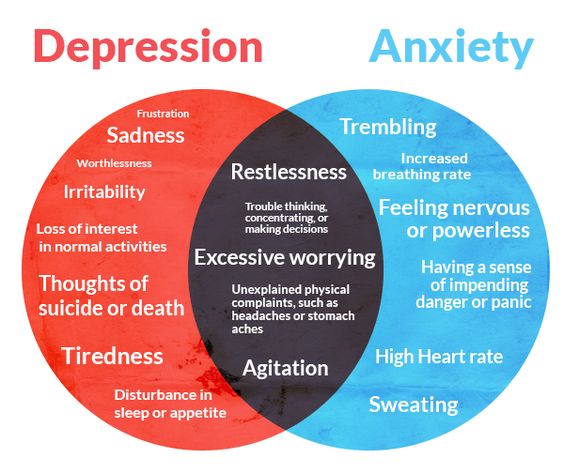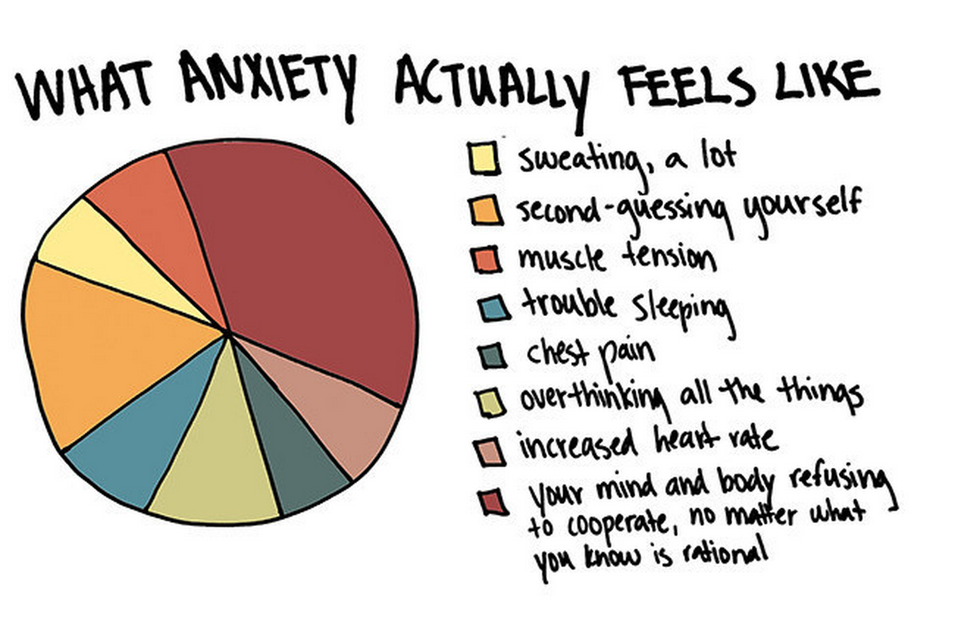Mental Health 201:
Anxiety and Depression
by Lindsey Turnbull, MissHeard Media
I shared an introduction to mental health (Mental Health 101) as part of National Mental Health Month. I wanted to look more closely as the two most common mental health issues in teens: anxiety and depression. Many times, these illnesses go hand in hand, sharing symptoms, and it is not uncommon for someone to be diagnosed with both.
All information provided here is a general overview and not a substitute for medical advice from a licensed professional!

Remember, there are many things that contribute to mental health issues, including genetics, prior trauma, experiencing racism and discrimination, poverty, and family history. None of these things are your fault! Also remember, there is no “look” to mental health issues- someone doesn’t need to “look” depressed to have depression.
Anxiety/General Anxiety Disorder
According to the American Psychological Association, anxiety is:
Anxiety is an emotion characterized by feelings of tension, worried thoughts and physical changes like increased blood pressure.
Teens with anxiety disorders can have recurring intrusive thoughts or concerns. They may avoid certain situations out of worry or fear. They may also have physical symptoms such as sweating, trembling, dizziness or a rapid heartbeat.
There are different kinds of anxiety too, general anxiety, social anxiety, and panic disorders.
Uh, doesn’t that sound like most people before they do something like take a test, give a speech, or perform on stage? Doesn’t everyone get anxious?
Sure. But those situations are temporary, and usually go away at the end of the test, performance or speech. Everyone gets anxious from time to time, and nerves can even help us to perform. Anxiety disorder means that those fears and worries persist longer, and more severely. Teens with anxiety may feel that butterflies-in-stomach, heart-racing, sweaty-palms feeling more often than not, and as a result may skip out on social situations, speaking up in class, etc. Teens with anxiety may even turn to drugs/alcohol in an attempt to self-medicate.
One of the biggest differences between anxiety and plain old worrying is that anxiety is persistent. It doesn’t go away after your big speech. A hot bath, hard workout, or marathoning a TV show may not provide relief, as it does for the general population.

Anxiety disorders can affect as many as one in 3 young people, a rising number that seems to shock parents and professionals alike. Studies show that girls are more likely to have/be diagnosed with GAD. Many parents and teachers can miss or overlook signs of anxiety, especially in teenagers. People with anxiety may build a whole life around their anxiety- they may control the situations they are in, so they are only ever with people and in places where they feel comfortable. Anxious people tend to want to please others and strive for perfection- so it goes unnoticed. As a result, they put tons of pressure on themselves, can be very hard on themselves, and fret about unlikely outcomes. Too often, anxiety goes unnoticed because outsiders are convinced an anxious person is totally fine, when they are struggling on the inside.
Some signs of teenage anxiety are:
- Recurring worries and fears about daily life
- Irritability
- Extremely self-conscious
- Chronic head/stomachaches
- Sleep problems
- Avoidance of new or difficult situations
- Withdrawal from social activity, which can include school
- Trouble concentrating
Not everyone experiences every symptom, or experiences them in the same way.
With help from a therapist, psychiatrist, and/or counselor, someone with anxiety can get the tools they need (which may include medication) to help them manage their anxiety and live a totally awesome life.
As a person who has spent many years in therapy, here are some things I learned that have helped me personally with my anxiety:
Remembering when anxiety is talking! Just because you pass someone laughing, doesn’t mean they are laughing at you. People are usually too busy worried about themselves to notice what others are doing These fears can be anxiety talking.
Notice your breathing. When we’re anxious, it’s like a constant state of flight/fight/freeze. Shallow breathing is common, and stresses our bodies even more. Taking long, slow, deep breaths can help regain control over an anxious mind.
Thought replacing. When we think “Oh God, this person is totally laughing at me,” try to replace it with a positive (and really, more likely!) thought like “Her friend just told a funny joke.” We can try to train our brains to focus on the most likely, non-anxious scenarios.
Face your fears gradually. Think of it like getting into the ocean: first you step in, then walk in up to your knees, then your stomach, chest, and finally you dunk your head under. If speaking in public really puts you on edge, spend extra time prepping gradually. Practice in front of your pets, then the mirror, then one parent, then your family, then your close friend group. By practicing over and over, you’ll build confidence to carry with you.
Treatment can and DOES help someone living with anxiety! Therapy, medication, and a combination of both are shown to lead to a reduction in anxiety symptoms!
Depression
Anxiety and depression can occur together– they share some symptoms and can feed one another. Depression, like anxiety, is one of the most common mental health issues that young people grapple with.
According to TeenMentalHealth.org, depression is
a mood disorder characterized by intense and persistent negative emotions. Depression affects the way he or she thinks, feels and acts. It becomes a negative lens through which he or she sees and experiences the world.
Sometimes a negative event (such as the loss of a loved one, or severe and prolonged stress) will trigger an episode of Depression but often episodes will occur spontaneously. Depression is not caused by the usual stresses of life. These emotions negatively impact people’s lives, causing social, educational, personal and family difficulties.
 Like wearing a pair of sunglasses inside, depression changes the way the world looks to someone with it. Depression can convince someone that they are ugly, stupid, broken, and unlovable. (None of these things are true!)
Like wearing a pair of sunglasses inside, depression changes the way the world looks to someone with it. Depression can convince someone that they are ugly, stupid, broken, and unlovable. (None of these things are true!)
There are different types of depression. The two main forms are major depressive disorder and dysthymia. Major depression lasts at least two weeks and may occur more than once in your life. Major depression may occur after a traumatic event such as a death in the family. Dysthymia is a less severe but chronic form of depression that lasts for at least two years. Manic depression (bipolar) disorder is characterized by mood swings with extreme highs and lows. Adjustment disorder is a short-term condition where someone struggles with an adjustment, such as a divorce or death of a loved one.
Everyone gets sad sometimes, especially if something bad happens, like failing a test, losing a sports game, or ending a relationship. Like with anxiety, the difference between “having the blues” and having depression are the severity, length, and persistence of the bad feelings. Someone who fails a test may cheer up in a week. Someone with depression feels like they’ll never cheer up.
Depression can look different in every person. In teenagers, depression is marked by emotional and behavioral changes such as:
- Feel sad, frustrated, or angry, even over small things
- Feeling hopeless, guilty, worthless, or empty
- Loss of interest in friends, family, normal activities
- Trouble thinking and concentrating
- Frequent thoughts of death, dying, suicide
- Irritable
- Changes in sleep including tiredness, insomnia, or sleeping more than usual
- Agitation or restlessness
- Changes in appetite
- Self-harm
- Unexplained body aches
- Use of alcohol or drugs
Not everyone experiences every symptom, or every symptom the same way.
The best treatment for depression is a caring therapist or counselor. Treatment can be a combination of therapy and medication. It can also help to reach out to someone. Depression may tell you that you are a burden, or that your friends won’t get it- but you may be surprised. You are not a burden- your friends and family want to help. They may not even realize you are in pain. Depression is not uncommon, and your friend may have experienced it too.
Depression may lead to suicidal thoughts (but not everyone who is depressed is suicidal). If you are having suicidal thoughts, or thoughts of self-harm, please get help immediately. The Suicide Hotline is completely free and available 24/7: 800-273-8255.
Personally, one of the hardest things to do when depression strikes is to get out and live life. It can be life-saving. Engaging in social situations can help alleviate depression and make someone feel less alone. So can volunteering- helping others can help ourselves! Snuggling with a pet can release feel-good serotonin too. (And for a double whammy, volunteer to walk dogs or snuggle kitties at a shelter.) Even soaking up some sunlight can boost your mood. Of course, none of these are a substitute for professional help!
In Conclusion:
If you think you are “more of a worrier” or “sadder longer/more often” than your peers, it maybe time to book an appointment with your doctor. There is nothing shameful about anxiety or depression, and these conditions DO NOT DISCRIMINATE. Anyone, regardless of age, race, religion, sexuality, gender identity, socioeconomic status, culture, etc. can have anxiety and/or depression.
Overall, girls are more likely to be diagnosed with anxiety and/or depression. Roughly half of all teens with mental illness do not receive treatment, which can have long-term implications. Anxiety or depression are not your fault, nor the result of anything you did “wrong.” It may require some hard work, but treatment (medication, therapy, etc.) works and is so worth it!
You can- and deserve to- live a happy and great life!
If someone you love has anxiety and/or depression, one of the best things you can do is be there for them. Check up on them and listen without judging. You can educate yourself on mental health issues, and refrain from sharing damaging memes/posts.
Further reading:
Mental Health 101: An Overview by Lindsey Turnbull
Mental Health 202: Eating Disorders by Lindsey Turnbull
Mental Health 301: Obsessive Compulsive Disorder by Lindsey Turnbull
Mental Health 302: PTSD by Lindsey Turnbull
VIDEO: 5 Things NOT To Say When a Friend Opens Up About Mental Health
Leaders, Your Mental Health Matters Too by Julia Schemmer
The Portrayal of Mental Illness in the Media by Tracy Yu
Lindsey’s Story: May is National Mental Health Month by Lindsey Turnbull
Resources:
MentalHealth.Gov
Teen Mental Health
Post It Forward
National Alliance on Mental Illness
Love is Louder
Take a screening for commonly diagnosed mental illnesses.
www.nami.org and The NAMI Fact Sheet Library
The National Institute of Health
How to Support a Friend (and what to avoid)
Black Emotional Mental Health Collective
The Trevor Project for Young LGBTQ Lives
National Asian American Pacific Islander Mental Health Association
National Alliance for Hispanic Health
Indian Health Service
You can also google “Teen Mental Health + your city” to find therapists who work with teens.
10 thoughts on “Mental Health 201: Anxiety and Depression by Lindsey Turnbull”